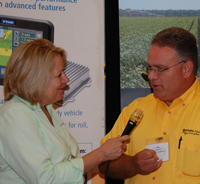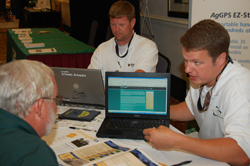 Growers need to focus on getting the right nutrient source applied at the right time, rate and place, says Steve Phillips, southeast region director of the International Plant Nutrition Institute (IPNI).
Growers need to focus on getting the right nutrient source applied at the right time, rate and place, says Steve Phillips, southeast region director of the International Plant Nutrition Institute (IPNI).
In his talk at the recent InfoAg precision agriculture conference, Phillips outlined the top 10 reasons why we need to understand spatial variability for nutrient management.
10. We need to understand variability to guide technology development. Understand the job to know what tools to use — GPS, GIS, variable rate, etc.
9. More accurate computer-generated modeling needed — to better understand crop scouting and yield, water quality, climate change and more.
8. Cropping system sustainability — such as soil quality on a spatial scale, variable-rate pest management, continued grower competitiveness, etc.
7. Guide nutrient management legislation. If we don’t help put science behind legislation (that is often based on models) then we’ll have policy makers creating laws not backed by science.
6. Maximize productivity — getting the right nutrients in the right locations because blanket applications are not efficient.
5. Maximize profits — using variable-rate applications and such in-season tools like GreenSeeker or Crop Circle that use sensors to prescription feed plants what they need on the go. Technology costs are coming down to help even small to mid-size farms make it pay.
4. Minimize environmental impact — more nutrients in the plant and less in the field.
3. This year is not last year — due to the impact of weather, growers too often get into the habit of applying the same rates every year.
2. Develop nutrient recommendation systems at the appropriate scale — take national/state recommendation down to the field management zone level.
1. Making the right decision with nutrient efficiency and effectiveness to increase productivity. Learn the 4R nutrient stewardship system.
Listen to Phillips’ presentation to learn more:
[audio:http://precision.agwired.com/wp-content/uploads/sites/3/2009/07/StevePhillips010.mp3]
Precision.AgWired.com coverage of the InfoAg 2009 Conference is sponsored by:  .
.

 Ten years of research by
Ten years of research by  In a move stated to help accelerate its information management capabilties to offer precision farming customers significant new capabilities,
In a move stated to help accelerate its information management capabilties to offer precision farming customers significant new capabilities,  The battle for water between agriculture and urban use only continues to gain momentum, yet both sides must focus on further efficiency.
The battle for water between agriculture and urban use only continues to gain momentum, yet both sides must focus on further efficiency. Speaking at the bi-annual precision agriculture
Speaking at the bi-annual precision agriculture  T.E. Moye, Jr. of Newton, GA was one of the winners of the 10th Annual Peanut Profitability Awards, sponsored by
T.E. Moye, Jr. of Newton, GA was one of the winners of the 10th Annual Peanut Profitability Awards, sponsored by  I recently attended the Southern Peanut Growers Conference blog and talked with representatives from
I recently attended the Southern Peanut Growers Conference blog and talked with representatives from  Brian says they listen to the needs of growers and bring the technologies to them. “We try to go to and work with the vendors we service, such as Trimble, in the interest of bringing those solutions the customers need, such as saving money on energy,” he said. “We’ve gotten to see a lot of these customers take precision ag full circle and see it make money and save on those energy costs.”
Brian says they listen to the needs of growers and bring the technologies to them. “We try to go to and work with the vendors we service, such as Trimble, in the interest of bringing those solutions the customers need, such as saving money on energy,” he said. “We’ve gotten to see a lot of these customers take precision ag full circle and see it make money and save on those energy costs.”

